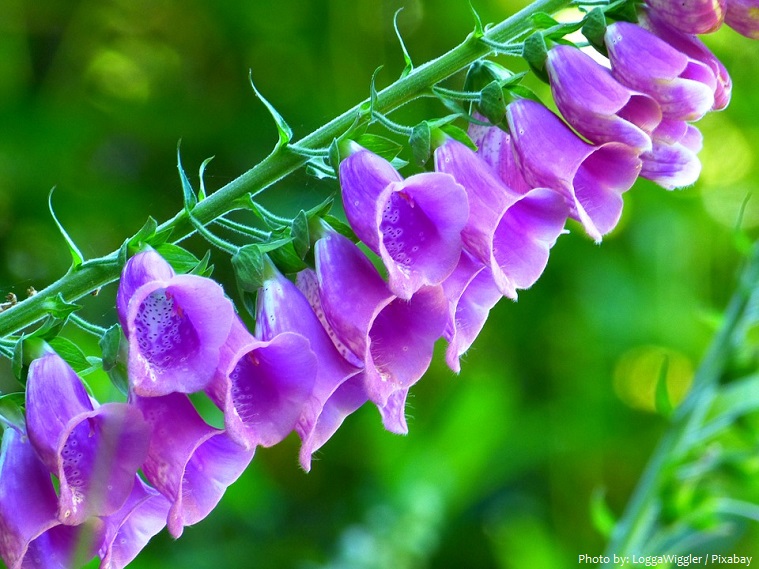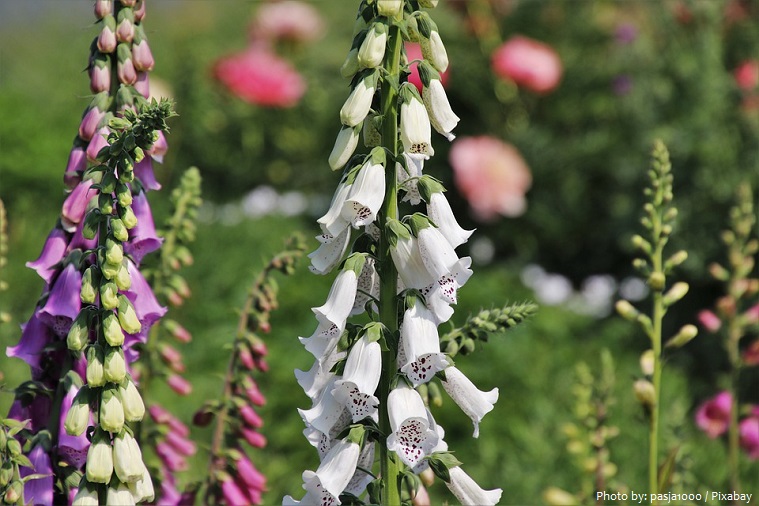Foxglove (genus Digitalis) is a genus of about 20 species of herbaceous plants (family Plantaginaceae).
The name “foxglove” was first recorded in the year 1542 by Leonhard Fuchs, whose family name, Fuchs, is the German word for “fox” (the plant genus Fuchsia is also named for him).
The genus name “Digitalis” is from the Latin digitus (finger), perhaps referencing the shape of the flowers, which accommodate a finger when fully formed.
Foxgloves are native to Europe, the Mediterranean region, and the Canary Islands, and several species are cultivated for their attractive flower spikes.
Foxgloves thrive in acidic soils, in partial sunlight to deep shade, in a range of habitats, including open woods, woodland clearings, moorland and heath margins, sea-cliffs, rocky mountain slopes and hedge banks.
Foxgloves typically grow to a height of 45 to 150 centimeters (18 to 60 inches).
It has grayish, hairy stem.
Foxgloves produce alternating, ovate to oblong leaves toward the lower part of the stem.
The stem is capped by a tall, one-sided cluster of pendulous, bell-shaped flowers, each of which may be up to 6.5 cm (2.5 inches) long. The flowers may be purple, yellow, or white and are often marked with spots within.
The fruits are dry capsules with numerous small seeds.
Some species are perennials but most species are biennials, meaning they flower during their second year and then die after seeding.
The entire plant is toxic (including the roots and seeds). Mortality is rare, but case reports do exist.
Foxglove flowers have both positive and negative symbolic meanings. They are said to sometimes hurt and sometimes heal. In the language of flowers, foxglove is associated with insincerity.
In folklore, it was said that picking a foxglove would offend fairies. This was likely a tale told to children to protect them, as these species of plant are toxic to both humans and animals if eaten.
Less commonly, these flowers are associated with religion, as they were planted in medieval gardens that were dedicated to the Mother Mary.
Digitalis toxicity results from an overdose of digitalis and causes nausea, vomiting and diarrhea, as well as sometimes resulting in xanthopsia (jaundiced or yellow vision) and the appearance of blurred outlines (halos), drooling, abnormal heart rate, cardiac arrhythmias, weakness, collapse, dilated pupils, tremors, seizures, and even death.
Vincent van Gogh‘s “Yellow Period” may have been influenced by digitalis therapy which, at the time, was thought to control seizures. As noted above, other oculotoxic effects of digitalis include generalized blurry vision, as well as seeing a “halo” around each point of light.
The common, or purple, foxglove (Digitalis purpurea) is cultivated commercially as the source of the heart-stimulating drug digitalis. The drug is obtained from the dried leaves.
Digoxigenin (DIG) is a steroid found exclusively in the flowers and leaves of the plants D. purpurea and D. lanata. It is used as a molecular probe to detect DNA or RNA.




